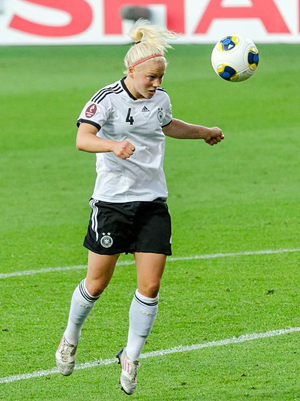Jan 31, 2017Seeing Clearly

Photo by Pechblaende via Wikimedia Commons
In women’s soccer, the act of heading the ball has been under scrutiny for increasing the chances of a player suffering a concussion. Of course, concussions occur in both men’s and women’s soccer, but current evidence involving high school players shows that females are being diagnosed more often than males.
In a 2013 article for Training & Conditioning, Maria Hutsick, MS, LAT, ATC, CSCS, Head Athletic Trainer at Medfield (Mass.) High School, describes seeing this phenomenon in her own experience. She noted that the small amount of head injuries that occurred on Medfield’s men’s team generally came from hitting the ground after being tripped by an opponent instead of from headers.
“I can’t say the same about the women’s team, which had several concussions due to repetitive heading of the ball,” Hutsick said. “One particular player who comes to mind was a midfielder known for her heading prowess. She began to have headaches, trouble in school, and a hard time comprehending information that she was learning in class. While she never had a specific concussion diagnosis, she eventually began showing signs and symptoms of post-concussion syndrome. She ended up having to take time off from the sport and was advised to avoid heading the ball when she returned.”
Although this discrepancy between male and female is a common occurrence, the reasoning behind it has been under recent investigation.
“While this is often attributed to gender differences in physical build or neck muscle strength, our study suggested that there might be other behaviors, such as field awareness, that are contributing factors that result in these higher concussion rates,” Joe Clark, PhD, Professor in the Department of Neurology and Rehabilitation Medicine at the University of Cincinnati College of Medicine, said in a UC Academic Health Center press release.
Dr. Clark and his fellow researchers conducted a study in which they studied pictures of soccer players heading the ball. They examined 100 images of both genders, with some pictures showing multiple athletes heading the ball at once. They found that with 170 females identified, 90.6 percent of them had their eyes closed while in the process of heading the ball. In contrast, only 76 percent of males had their eyes closed.
The correlation between closed eyes and heightened risk of concussion is too significant to be ignored, say the researchers. In order to lessen the injuries sustained through heading the ball, Dr. Clark offers a strategy for becoming more aware of one’s surroundings.
“In other studies, vision training has successfully reduced the rates of concussion in college football athletes; overall lack of visual awareness in a contact sport may increase the risks of concussion,” he says. “Therefore, vision training and better eye discipline may decrease concussion rates.”
Dr. Clark spends time working with high school and college-level athletes on a method known as “eye discipline.” This process helps players be more conscious of the ball and other players before a hit.
“The startle reflex, or blinking or closing one’s eyes upon a perceived risk, can be suppressed through training and coaching,” he says. “So it is possible that training to improve eye discipline and maintain control of ball handling may help mitigate concussions in soccer players heading the ball.”
To read more about how Dr. Clark has used vision training to increase safety and improve performance in Cincinnati athletes, check out this article from the May/June 2016 issue of Training & Conditioning.



